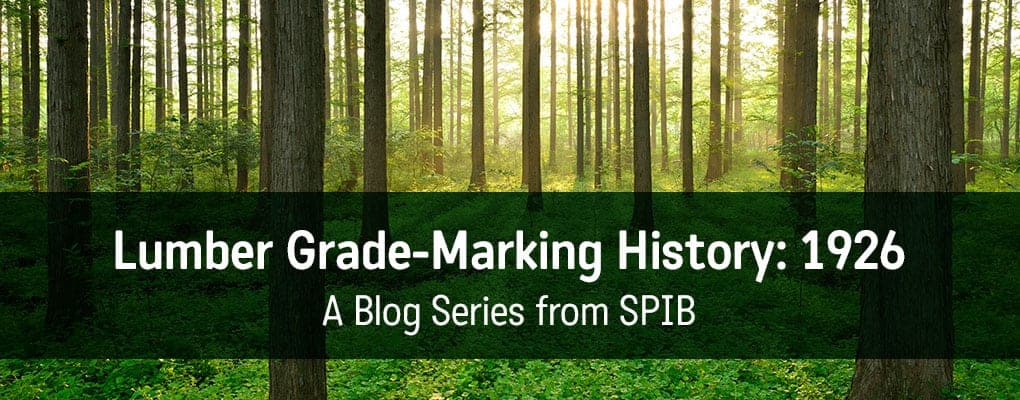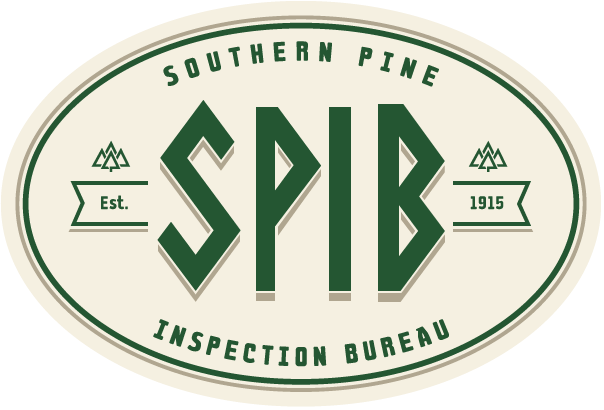
Lumber Grade-Marking History: 1926
Introduction
1926 was a record-breaking year in a wide range of different ways. In February, real estate on Broadway and Wall Street in New York City were sold at a record $7… per square inch. Certainly a sign of things to come.
In August, a weather map was televised for the first time, directly from NAA Arlington to the Weather Bureau Office in Washington, D.C.
1926 was also something of a transformative year for the lumber industry. In this section, you will learn about how this was finally the year when the problems being faced with lumber manufacturing and grading improvement received the coordinated attention they always needed. You’ll learn about the first better construction and grade-marking campaign that was conducted in Miami with tremendous success, immediately following a massive hurricane that hit Florida during the year.
You’ll find out more about the first big Oklahoma meeting for grade-marked lumber that took place in May and was attended by The Mid-Continent Retail Lumber Dealers’ Association, the Tulsa Chapter of Associated General Contractors, and the Oklahoma Board of Examiners of Architects, among others.
You’ll also learn about the continued evolution of grade-marking in general, and the tremendous gains that were made in terms of the improvement in moisture content – something that was considered to be a means of assuring grade quality and that the lumber across the board.
We trust that you will continue to find this journey enlightening, as it makes clear what can happen when so many people with similar interests gather together in support of the greater good.
1926
The problems arising coincident with lumber manufacture and grading improvement received coordinated attention. The grade-marking campaign, begun in 1925 and continued in 1926, brought wood construction directly to the building trades and professions, public officials and financial interests. Regional and local inspectors educated in the then one big single aim of the Southern Pine Association “the merchandising of southern pine” were established in Chicago, Detroit, New York and elsewhere. Grade-marking by subscribers reduced complaints on lumber shipped and fewer claim inspections resulted.
The first better construction and grade-marking campaign was conducted at Miami with great success – following the hurricane in Florida, both during 1926.
Timber specifications to meet the particular grade rule requirements of engineers, architects, consumers and modern merchandising necessities, were revised.
Standardization and grade-marking were approved for Tulsa, Oklahoma, and environs, by wholesalers, retailers, contractors, architects, realtors, engineers, building loan officials and the public. Pedigreed lumber was favored because the customer, under grade-marking could see what he was getting. His innocence was protected. The dealer was relieved of worry and the home-buyer reassured. The Mid-Continent Retail Lumber Dealers’ Association, the Tulsa Chapter of Associated General Contractors, the Oklahoma Board of Examiners of Architects, the Oklahoma State Chapter of Architects, the Home Building and Loan Association, the Southwestern Lumbermen’s Association, and the Real Estate Board of Tulsa were represented at the first big Oklahoma meeting for grade-marked lumber – May 21, 1926. Lumber dealers were accused of sitting idly by, preferring to keep people in the dark about their business. Advertisers were capitalizing on this situation by extolling the suitability of lumber substitutes. People didn’t know anything about lumber and couldn’t find out. Many thought it was a flimsy and dangerous material. Education of the consuming trade became necessary.
Retailers, contractors, and others, of Pennsylvania, Wisconsin, and Michigan commended grade- marking. Many communications were received attesting to its value, the elimination of questionable practices, and the improvement of internal mill organization. Several manufacturers, aroused by the indifference of others, declared that the expense of grade-marking was producing excellent returns; and that they would continue grade-marking even though the movement was dropped by others. Drastic changes for the betterment of labor conditions at the mills, automatically developed since grade-marking started, were reported. A more intimate responsibility, with the pertinent pride of efficiency and accurate work, was assumed by the manufacturing personnel. In dollars and cents the value of grade-marking to the manufacturers was considered great.

The grade-marking of lumber by all manufacturers of southern pine was the desired accomplishment in order to properly support the fact that trade-marked southern pine was available in all quantities. The grade-marking principle was active with the Northern Hemlock and Hardwood Manufacturers Association, the California White and Sugar Pine Association, and the California Redwood Association.
Understood by many to be an established policy of the Southern Pine Association, surprise was occasioned that there existed a tendency on the part of a few manufacturers to discontinue or abandon grade-marking. A concerted effort was made to ascertain the reasons therefore. Divided opinions resulted in some territories and sections. All species of southern pine were intended for inclusion. No attempt was made to force the practice of grade-marking; the subject was left to seek its own course. Some difficulties and irregularities arose and the status of grade-marking among subscriber mills was not as encouraging as was thought possible. While some mills reported opposition to grade-marked lumber by their trade, there were many who had the opposite experience. Some subscribers stated that their trade not only liked it, but demanded it.
55 out of 84 member mills grade-marked their lumber. The production of mills grade-marking, either practically or wholly, represented 67% of the total production of the Southern Pine Association. Committees, composed of manufacturers delegated to interview manufacturers not grade-marking, were appointed for each of the States in which subscribers operated.
More legible marking was wanted – Association inspectors regularly visited the plants to assist.
Improvement in moisture content amount was considered to be a means of assuring grade quality and that the lumber would not “work” when put in place. A declaration by manufacturers to the trade that they shipped lumber of proper moisture content was thought to be of competitive advantage.
Believing that the grade-marking of lumber is a step forward in the merchandising of our product, we, the subscribers of the Southern Pine Association, reaffirm our position with regard to it, and ask those subscribers not now grade-marking to give the matter serious consideration on the theory that in unity there is strength.
The above resolution, designed to induce grade-marking by all manufacturers, was passed.
Grade-marking was championed by the U. S. Department of Commerce. It strongly emphasized the intent and effect, that:
The grade-marking of lumber is meant the placing on each piece of lumber a brand or mark indicating its grade.
Grade-marking should be an adjunct to the standardization plan, without which the latter will not be successful.
Grade-marking cannot succeed unless conscientiously carried out.
Many commodities, other than lumber, have for years been grade-marked.
Although the grade-marking idea originated with the manufacturers, the main benefit will be to the consumers.
Lumber, unlike many other articles, cannot be analyzed by any physical or chemical means to determine grade.
Grade-marks on each piece of lumber would in time educate the consumer to a better knowledge of grades.
Grade-marking of lumber will stimulate the demand for the lower grades.
Grade-marking of lumber will assure the consumer of receiving certain grades suitable for certain purposes with the logical consequence of business stabilization.
Grade-marking will strengthen the position of the legitimate middlemen and distributors.
Grade-marked lumber will be bought and sold in standard grades and sizes without a detailed inspection.
Grade-marking will afford protection to the honest distributors and weed out the parasites.
Grade-marks make for the best salesmen.
The small expense of grade-marking will have no effect on the cost of Lumber.
World experience with ungrade-marked lumber evidences the promotion of suspicion where identity is concealed.
In the Old World trade circles, the absence of grade-marks means that the manufacturer refuses the responsibility for grade integrity.
Grade-marking stands for honest practices.
